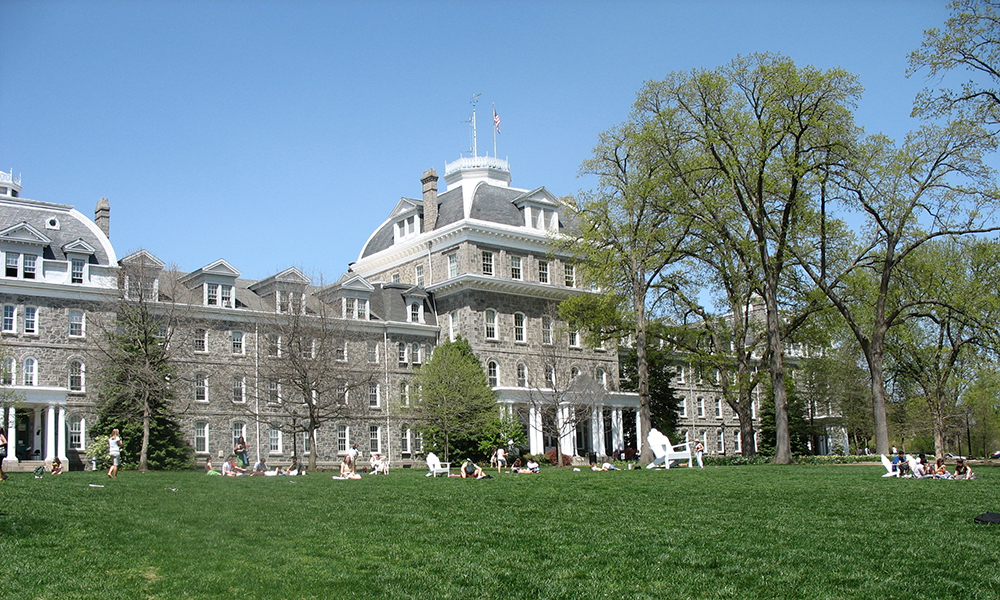IvyWise On-Demand: A Look Inside STEM Colleges with Former Admissions Directors
Join IvyWise college admissions counselors Katie and Rod as they explain what it means to study a STEM major and share some examples of colleges and universities where these majors are popular, including the schools where they worked: MIT and Case Western Reserve University. You will learn how to build your balanced college list and how to stand out when applying as a STEM student.
Watch Now
By Mari, IvyWise College Admissions Counselor
I work with a lot of STEM-oriented students, many of whom are interested in engineering. When we start discussing their college list, it’s a parade of the usual suspects: MIT, Caltech, Georgia Tech, Cornell, University of Michigan, etc. But these schools aren’t right for everyone for various reasons — including size, location, and selectivity — and I enjoy telling families about other options that they have either never heard of or that might not be top of mind for them. Let’s look at four of these schools with strong engineering programs.
Olin College of Engineering: Needham, Massachusetts
Located 14 miles west of Boston in Needham, Massachusetts, Olin College of Engineering might not be on your radar for a couple of reasons. First, it’s a small undergraduate college with approximately 400 students. Second, it’s only been around since 1997. For those in the know, like the engineering and tech companies that regularly recruit here, Olin’s unique but rigorous approach to engineering education has proven its value.
Olin isn’t structured around traditional departments, but students earn an ABET-accredited degree in electrical and computer engineering, mechanical engineering, or engineering — a flexible degree that allows students to pursue a concentration in bioengineering, engineering computing, engineering design, engineering robotics, engineering sustainability, or one of their own design. Most classes are project-based, with short lectures followed by application of concepts, often in teams. This approach culminates in the Senior Capstone Program in Engineering (SCOPE), a year-long collaboration between Olin students and industry partners on an in-depth, real-world project.
The tight-knit, supportive, and welcoming community is a hallmark of the Olin experience. Faculty, whom students call by their first names, are readily accessible and passionate about teaching and collaborating with students. Dorm lounge culture thrives at Olin with 99% of students residing on campus all four years. Students work together to get through difficult classes and take the Honor Code seriously, which fosters an extremely safe environment with tremendous trust between community members. Olin’s partnerships with nearby Babson College, Wellesley College, and Brandeis University provide students with access to a wealth of classes outside of STEM, as well as opportunities for academic collaboration, athletics, and socializing.
An Olin education won’t break the bank, and graduates are well positioned to jump into satisfying and lucrative careers or graduate school. Olin provides all students with a 50% discount on tuition over eight semesters and meets full demonstrated need for those requiring additional financial aid. Olin’s career center engages with students starting in the first year, and the average starting salary for grads is $100K. For any prospective engineering student who values hands-on, collaborative learning with easy access to a major city, Olin is worth a very serious look!
University of Rochester: Rochester, New York
When I work with students, I often encourage them to add the University of Rochester to their list because it’s an amazing school, not only for engineering but also for liberal arts and sciences. Plus, the admissions rate isn’t too intimidating — the overall acceptance rate for the class of 2027 was 35.85%. The campus sits on the banks of the Genesee River in the beautiful Finger Lakes Region of Upstate New York. The city of Rochester has a thriving arts scene and has become a hub of the high-tech industry. As a mid-sized institution in a mid-sized city, Rochester offers a perfect blend of opportunities and resources in a livable, affordable environment.
Rochester divides majors into three broad categories: natural sciences and engineering, humanities, and social sciences. One distinctive feature of the curriculum is its flexible “Clusters” requirement. In addition to the classes for their major, students must take at least three related classes, or “Clusters,” in each of the two academic categories outside of their major. Clusters allow students to take non-major classes that they are truly interested in, instead of the usual distribution requirements. Considering the demands of their major, engineering students are only required to complete one cluster. All students must complete a primary writing requirement.
Students take academics and career preparation seriously: 30% of students double major, 77% of students engage in research, and 95% participate in internships. The University of Rochester Medical Center provides a wealth of research opportunities to students, including those participating in REMS, the ultra-selective eight-year B.A./B.S. + M.D. program. Other signature combined degree programs include GEAR (a five-year B.S. + M.S. in an engineering and applied sciences discipline), GRADE (a five-year B.A./B.S. + M.S. in Education), and HEAL (a five-year B.A./B.S. + master’s in public health). Through the university’s world-class conservatory, Eastman School of Music, students who have been admitted to both the conservatory and the College of Arts, Sciences and Engineering can pursue a dual degree program (B.A./B.S. + Bachelor of Music).
The university meets 100% of demonstrated financial need for all admitted students. Unlike most schools, this includes international students, although the admissions criteria are high for international students who require aid. The university offers merit scholarships ranging from $5,000 to $25,000 per year. Take Five and e5 programs allow qualifying students to enroll tuition free for a fifth year to pursue additional studies or an experiential project.
The campus community embraces the concept of “Meliora,” which translates to “ever better.” With everything that the University of Rochester has to offer in conjunction with this commitment to values-centered excellence that binds students, faculty, administrators, and alumni in a common purpose, this school has begun to gain traction as a “New Ivy.”
Rose-Hulman Institute of Technology: Terre Haute, Indiana
Founded in 1874, the Rose-Hulman Institute of Technology sits on the banks of the Wabash River in Terre Haute, Indiana — a small, quintessentially Midwestern city. Regionally, Rose’s reputation for robust STEM education is no secret, and for 25 years in a row, U.S. News and World Report has ranked the school No. 1 in engineering education for colleges that do not offer engineering Ph.D.s. If you’re interested in a rigorous STEM education in a safe environment within a welcoming community of about 2,150 undergraduates, I recommend adding Rose-Hulman to your college list.
Academics emphasize hands-on learning, collaboration, and an innovative mindset. The work is not easy, and the pace of the quarter system requires students to manage their time well; however, students describe Rose as a place that’s easy to grow with where everyone has your back. Professors know students by name and foster a culture where it feels safe to fail. In addition to undergraduate majors across science, math, and engineering disciplines, Rose-Hulman offers “Rose Squared,” a program where students earn a B.S. plus a Master of Engineering Management (MEM) in four years.
The school’s facilities are impressive, and work was completed in 2021 on a facility with state-of-the-art laboratory spaces, classrooms, areas that encourage collaboration, and a food sciences laboratory. Additionally, the Branam and Kremer Innovation Centers, or BIC and KIC, house makerspaces and workshops supporting academic, co-curricular, and entrepreneurial activities in a dynamic space.
During their time at Rose-Hulman, most students participate in at least one co-op or internship. Rose-Hulman Ventures, a collaboration between the institute and industry, provides students with direct opportunities to work on real projects, which can lead to job offers after graduation. The average starting salary of graduates is about $79,000, and students rave about the personalized career planning that’s available.
With its tight-knit student body and 150-year history, Rose-Hulman values its traditions. Homecoming is a major event, including a bonfire and cool drone show at night, as is Pi Day, befitting an institute of technology. On Move-In Day, even the president can be seen pitching in to move boxes into dorms — it’s that kind of place.
Union College: Schenectady, New York
Founded in 1795, Union College provides a stellar educational experience to just over 2,000 undergraduates. Located in Schenectady, New York, the campus is within walking distance of the thriving, revitalized downtown area. Twenty miles from Albany, Union benefits from the resources and opportunities of the Capital District. The Nott Memorial — the iconic, architecturally eclectic, 16-sided building that is the jewel of the campus — is a fitting symbol of Union’s blend of old and new; theory and practice; and diverse academic offerings in the arts, humanities, social sciences, sciences, and engineering.
Union emphasizes the immersive experience of this residential community through small class sizes, close relationships with faculty, abundant opportunities for experiential learning through research and internships, and its signature Minerva House system. The Minervas are “third spaces” that merge academics, social activities, and residential life. Incoming students are assigned to a Minerva and remain affiliated throughout their time at Union. Students can take advantage of many opportunities for connection with other students as well as faculty who are also active members of the Minerva. Intentionally un-themed, the Minerva Houses foster mingling of diverse types of students through first-year seminars, planned social events, and casual gatherings.
Union began offering engineering in 1845 and is the first U.S. liberal arts college to do so. Engineering students at Union enjoy the advantages of a small college, including a supportive, collaborative culture where professors know you by name, plus the resources of a much larger university. The Integrated Science and Engineering Center (ISEC) demonstrates Union’s commitment to STEM education, as does the college’s investment in world-class instrumentation — for example, two atomic force microscopes and a full-sized wind tunnel.
Other things that define the Union experience include strong advising, a robust study abroad program, dedicated support for students seeking prestigious fellowships, and a network of engaged alumni. Add to this, vibrant student life activities from varsity sports (hockey is big) to the arts, community service opportunities, and co-curricular clubs and you may conclude that Union is the place for you! Over 50% of students receive need-based financial aid and over 30% receive merit scholarships ranging from $18,000-$30,000 per year, making Union affordable to many.
I hope this glimpse into four hidden gems for prospective engineers has inspired you to do more research on colleges beyond the ones that get the most press. Whether you want to pursue STEM or a different interest, the expert college counselors at IvyWise can recommend schools that are a great fit for your needs and goals. Not only that, but we can guide you through every phase of the admissions process and help you submit a strong application that sets you apart. Schedule an Initial Consultation to learn more.
Want more hidden gem college recommendations from our counselors?




